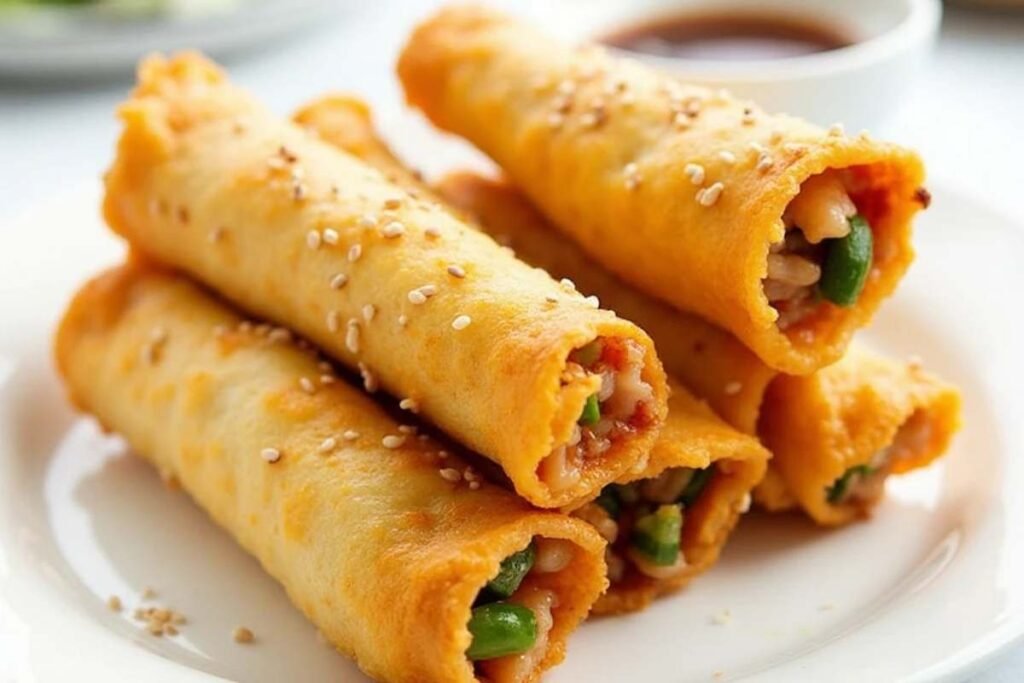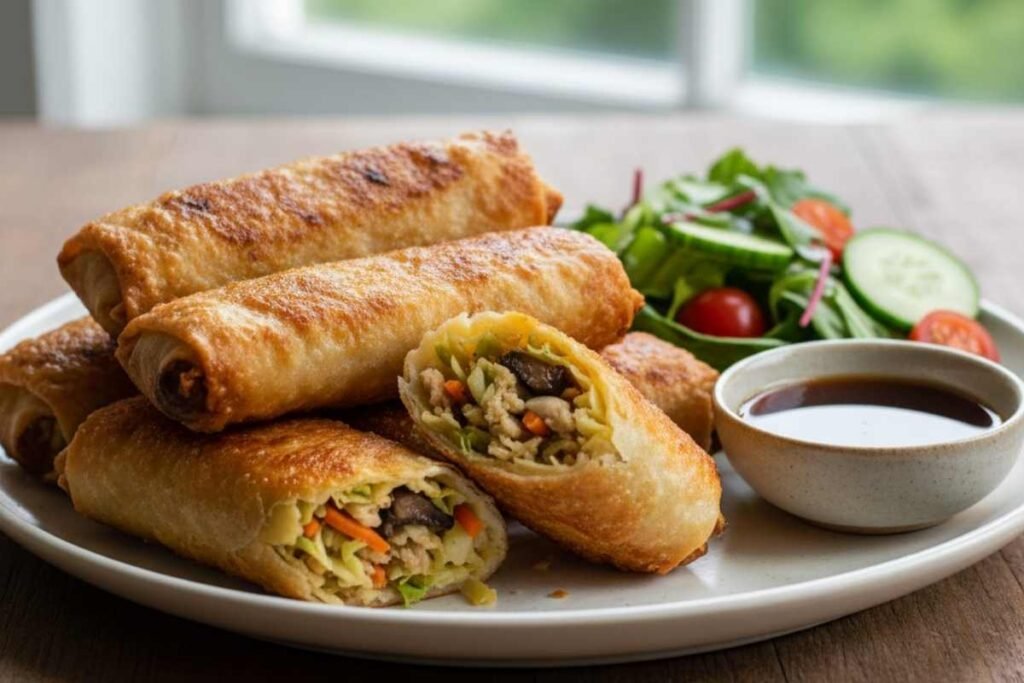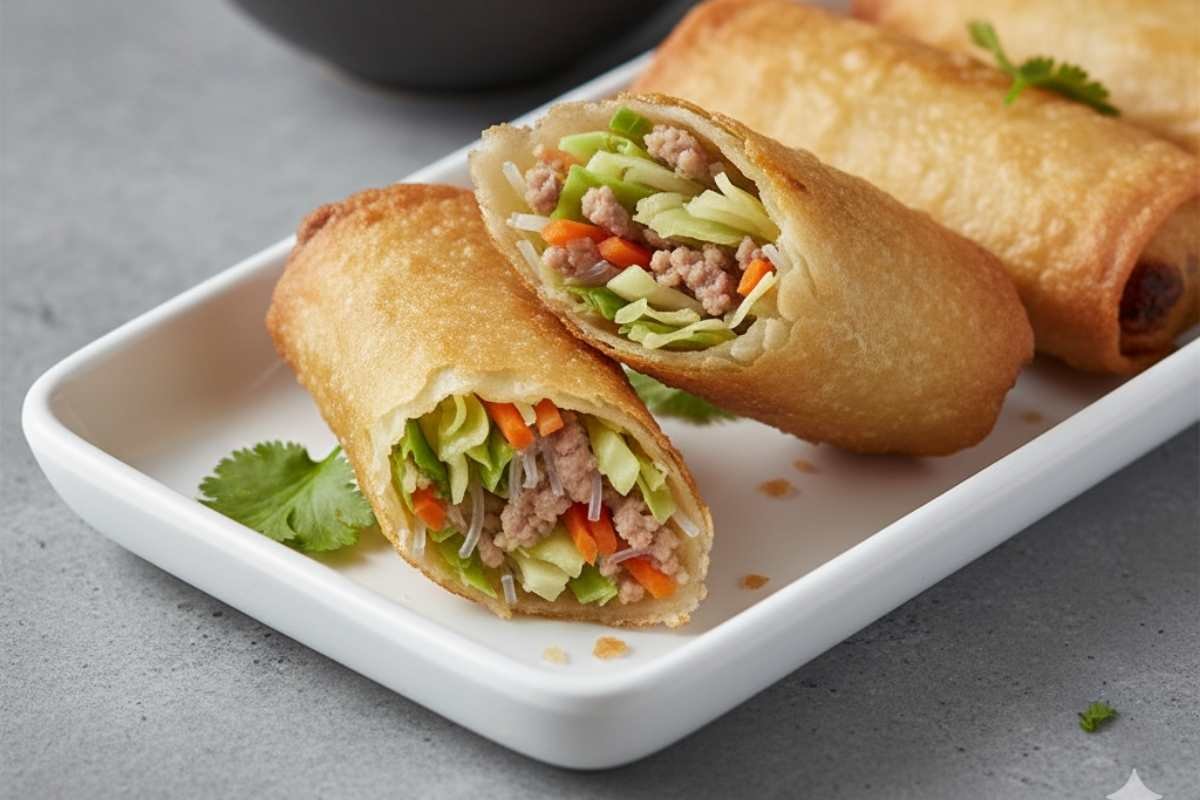If you have ever bitten into a golden crunchy egg roll and wondered if you could enjoy the same treat without gluten you are in the right place.
These homemade gluten free egg rolls deliver a satisfying crunch while keeping the filling flavorful and fresh. From perfectly thin wrappers to savory well balanced fillings each step matters to get that ideal texture.
Whether you are preparing a snack appetizer or meal these egg rolls prove that gluten free can still be delicious.
Simple ingredients and careful prep make them easy to make at home. Allthefallen represents this article guiding you to master these crispy delights with ease.
What Is a Gluten Free Egg Roll?

A gluten free egg roll is a tasty version of the traditional snack made without wheat or gluten containing ingredients. Instead of regular wrappers it uses rice flour or specially prepared gluten free dough that crisps beautifully when cooked.
Inside the filling is typically a mix of vegetables and protein seasoned to create a flavorful bite every time. The goal is to replicate the classic crunch and savory taste while keeping it safe for people with gluten sensitivities.
These egg rolls are versatile perfect as appetizers snacks or part of a meal. With careful preparation gluten free egg rolls can be just as satisfying as their traditional counterparts.
Ingredients Needed!
Making gluten free egg rolls starts with a few essential ingredients that create both the wrapper and the filling. For wrappers a combination of rice flour tapioca starch and eggs provides the right texture and structure.
The filling typically includes shredded cabbage carrots and protein such as ground chicken pork or tofu. Flavorings like garlic ginger sesame oil and gluten free soy sauce enhance the taste without overpowering the other ingredients.
A small amount of cornstarch helps bind the filling and keep it from leaking during cooking. Neutral oil is required for frying but baking is also an option for a lighter version.
Preparing the Wrappers!
To make the wrappers begin by mixing rice flour tapioca starch and eggs until a smooth dough forms. Roll the dough into thin sheets about one eighth inch thick to ensure crispiness when cooked.
Cut the sheets into uniform squares usually three and a half to four inches for easy rolling. Lightly sprinkle with tapioca flour to prevent sticking and maintain shape.
Stack and cover the prepared squares while you work on the filling to keep them from drying out. Proper handling at this stage prevents tearing and ensures a consistent texture in the final egg rolls.
Making the Filling!
The filling should be flavorful yet compact to fit neatly inside each wrapper. Begin by cooking your protein of choice until fully done and then drain any excess liquid.
Add shredded vegetables like cabbage and carrots along with seasonings such as garlic powder ginger and sesame oil. Mix thoroughly then sprinkle in cornstarch to bind the mixture and prevent moisture from escaping during frying.
Allow the filling to cool slightly before rolling to make handling easier. Properly prepared filling ensures each egg roll has a balanced taste and maintains its shape during cooking.
Rolling the Egg Rolls!
Place a wrapper with one corner facing you and spoon two tablespoons of filling near that corner. Fold the corner over the filling then roll tightly while tucking in the sides.
Moisten the final edge with a small amount of water to seal the roll securely. Ensure there are no trapped air pockets as these can cause the oil to splatter.
Set each rolled egg roll aside on a lightly floured surface or tray. Consistent rolling technique keeps each egg roll uniform and prevents filling from spilling during cooking.
Frying the Egg Rolls!

Heat neutral oil in a skillet or fryer to 350°F for optimal crispiness. Carefully place the rolled egg rolls into the hot oil making sure not to overcrowd the pan.
Fry each side for about one minute until golden brown and crisp. Remove from oil and place on a wire rack to drain excess oil and maintain crunchiness.
Avoid touching them immediately to prevent tearing the wrappers. Frying requires attention but the result is a perfectly crispy outer layer that complements the savory filling inside.
Serving Suggestions!
Serve gluten free egg rolls warm for the best texture and flavor. Pairing them with a simple dipping sauce like tamari or a light vinegar based sauce enhances the overall taste.
They can be presented as an appetizer snack or part of a meal alongside fresh vegetables. Cutting the egg rolls in half allows for easy sharing and a visually appealing presentation.
Plate them neatly to maintain the crisp appearance and avoid stacking while still hot. Simple garnishes like sesame seeds or green onions add subtle color without altering the flavor.
Storage Tips
If you have leftovers store them in an airtight container in the refrigerator for up to three days. Reheating in an oven or toaster oven preserves the crispiness better than a microwave.
For longer storage raw egg rolls can be frozen before frying but wrap them individually to prevent sticking. Thaw at room temperature before cooking to ensure even heat distribution.
Always check the filling temperature to confirm it is thoroughly heated before serving. Proper storage and reheating maintain both safety and taste for future enjoyment.
Troubleshooting Common Issues!
Wrappers tearing or splitting usually means they were rolled too thin or not handled gently. Moisture in the filling can cause sogginess so ensure excess liquid is drained and cornstarch is mixed in.
Oil temperature that is too low leads to greasy egg rolls while oil that is too hot can burn the wrapper before cooking the filling.
Maintaining uniform heat and careful rolling helps prevent these problems. Using a wire rack for draining reduces contact with excess oil. Adjusting these small factors creates consistently well cooked gluten free egg rolls.
How to Serve and Enjoy Gluten Free Egg Rolls?

Serving gluten free egg rolls is all about maintaining their crispiness and showcasing the flavorful filling inside. They are best enjoyed warm fresh from the fryer or oven to preserve the satisfying crunch of the wrapper.
Pairing them with a light dipping sauce such as tamari or a mild vinegar based sauce enhances the taste without overpowering it.
You can serve them as appetizers snacks or alongside a simple salad or steamed vegetables for a complete meal.
Cutting them in half makes sharing easy and adds visual appeal to your plate. With proper presentation and care gluten free egg rolls can be as inviting and delicious as any traditional version.
Conclusion
Gluten free egg rolls are a delicious way to enjoy a classic favorite without gluten. Making them at home allows for control over ingredients ensuring a healthy and tasty result.
Proper preparation of wrappers and filling is essential to maintain the ideal texture and flavor. Rolling and frying techniques play a significant role in achieving the perfect crunch.
They are versatile and satisfying suitable for snacks appetizers or meals. With careful attention to each step homemade gluten free egg rolls provide a rewarding and flavorful culinary experience.
FAQs
What are gluten free egg rolls?
Gluten free egg rolls are a version of the traditional snack using wrappers without gluten.
Can I bake instead of frying them?
Yes baking is possible and gives a lighter version with less oil.
How long can I store leftovers?
They can be refrigerated for up to three days in an airtight container.
Can I use different proteins?
Chicken pork tofu or shrimp can all be used as the filling.
Are gluten free egg rolls suitable for kids?
Yes they are safe and enjoyable for children with gluten restrictions.




